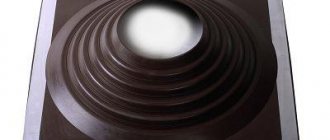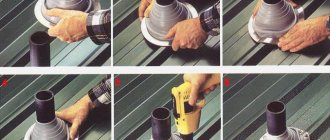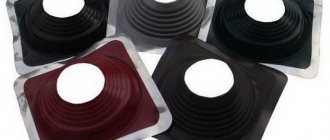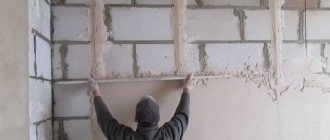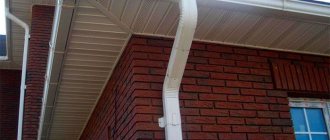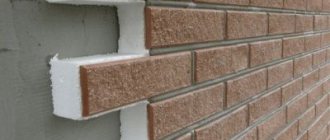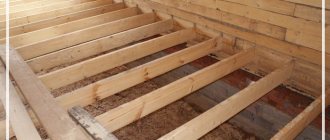Profiled sheets are used for arranging the roofs of residential buildings, cottages, bathhouses, garages and many other types of buildings and structures. The material is distinguished by its presentable appearance, strength, durability, and is easy to install with your own hands. Craftsmen have to face the problem of sealing chimney passages through the flooring. An effective solution to this issue is to install master flash on metal tiles. This device is also excellent for coatings such as ondulin and slate.
What is Master Flush
Master Flash ensures the sealing of the pipe.
The Master Flash penetration is a two-component product made of sheet metal and an elastic truncated cone. The base is an aluminum plate with a side of up to 80 cm. The top is made in the form of a straight pyramid with protrusions in height. The connection of the parts is made by soldering and is absolutely sealed.
The principle of operation of the Master Flash penetration is to simultaneously press the flexible part against the pipe, and the rigid part against the roof surface. The remaining cracks are sealed with a sealant, and the metal itself is tightly screwed to the flooring.
Equipment
Using the Master Flash penetration is the simplest way to insulate the joint between the chimney and the roof. Its installation takes no more than 30 minutes, and it lasts at least 15 years. To do the installation yourself, you will need:
- Master Flash penetration of the appropriate size made of silicone or rubber. Choose a model based on the diameter of the chimney pipe and the temperature of the gases inside it. Pay attention to the base of the product: products with a metal-reinforced flange last longer, however, it provides a poor fit to textured roofing materials.
Corner penetration
Direct penetration - Plate. This term refers to a galvanized steel product that is placed over the penetration to protect from sunlight. Outwardly, it resembles a plate without a bottom; ready-made models are sold in hardware stores, but making such a device with your own hands from sheet steel is also quite simple.
Drawing of a decorative plate for decorating a passageway - Fasteners, sealant and screwdriver. If you do the installation yourself, you will need self-tapping screws with a press cap, a heat-resistant silicone-based sealant and a screwdriver.
Note! At each penetration stage, the corresponding pipe diameter is indicated. To prepare the Master Flash for installation with your own hands, you need to accurately determine the size of the chimney and cut the device according to the mark with ordinary scissors. Experienced roofers say that the hole in the flexible penetration should be 20% smaller than the pipe.
Advantages and disadvantages
The products have the following advantages:
- Tightness. The materials used are flexible and resilient. Provides tight pressure to the pipe and flooring of any configuration.
- Elasticity. The products are suitable for slopes of any steepness, surface relief and material of protruding fragments.
- Strength. All components of the penetration correspond to the resistance to mechanical loads of the roof covering.
- Versatility. Parts can be equally successfully installed on smooth, wavy and profile coatings with all types of patterns. The scope of application is simply unlimited.
- Durability. The materials used in production are resistant to ultraviolet radiation, abrasives, and chemical reagents.
- Easy and quick installation. The whole procedure takes no more than 15 minutes in summer and an hour in winter, when it is necessary to clear the work area of snow. Detailed instructions for the product help you do everything accurately and accurately.
- Quite affordable cost, similar to the cost of the kits that were used before.
When the temperature rises to a critical level, the flexible cone lights up. This imposes certain restrictions on the scope of use of the products.
Why is it needed?
Master flush is a universal type of sealant for effectively insulating roof penetrations. The device can be used for all types and coverings of roofs. Well suited for roofs made of metal tiles, corrugated sheets and tin. Installation of the penetration can be carried out both on a roof with a metal deck, and on a soft roof, sand-cement or slate.
An important advantage of the device is its resistance to temperature changes and exposure to sunlight. Therefore, installation of the penetration can be carried out at any time of the year and at any temperature.
- Flexibility. With the help of a sealant it is easy to create a tight fit to the chimney;
- Heat and frost resistance;
- Not susceptible to oxidation;
- High strength of the material;
- High level of sealing against water ingress;
- Resistance to deformation;
- Long warranty period up to 30 years;
- Easy to install;
- Savings on additional waterproofing work around the device.
Varieties and Selection of Master Flash
Products of domestic and foreign production go on sale. Seals are distinguished according to the material used to make the flexible and rigid parts.
Cones are made from the following polymers:
- Rubber. Ethylene propylene rubber, which belongs to the class of synthetic elastomers, has high elasticity, flexibility, and a high degree of moisture protection. The EDPM standard material has a porous structure, low thermal conductivity, and immunity to fats and mineral oils. Such penetrations can be mounted on structures whose temperature does not exceed 100 degrees.
- Silicone. These seals are designed for higher temperatures and have a heating limit of 240 degrees. As it increases further, the material melts but does not burn. Ultraviolet intolerance can be considered a minus. With intense solar radiation, silicone hardens over time, cracks and loses its seal.
The plates are made of galvanized iron, stainless steel and aluminum. The pricing policy for each metal is different, but the performance indicators are also higher depending on the price.
Elastic nozzles are available in straight and inclined versions. The standard is 90, 30 and 45 degrees. At the same time, the pyramids are flexible and elastic enough to easily close pipes with a deviation of up to 20 degrees from the declared value.
At each level of the pyramid there is an inscription about the corresponding internal diameter. The technician just has to measure the size of the canal and cut off the excess with ordinary scissors. It must be taken into account that the cross-section of the lining should be 20-25% smaller to ensure a tight and airtight connection.
Sealant and self-tapping screws are included with the penetration. It is necessary to use components that are resistant to environmental influences. Since the plate will still be painted over, the color does not matter. A silicone washer and a drill before threading screws are required.
About the conditions of use
An elastic rubber penetration would be an excellent option for ensuring reliable waterproofing in the chimney passage area. But it will not be appropriate in all cases. Experienced experts say that such a device is suitable for equipping the following smoke exhaust channels:
- Sandwich chimneys. These pipes have two contours made of durable galvanized steel, between which there is a layer of thermal insulation, most often represented by basalt fiber. This material retains heat through the inner pipe, which is why the outer part of the chimney does not warm up much, remaining practically cold. Optimal waterproofing of sandwich pipes - rubber models.
- Stainless steel chimneys, through which combustion products are discharged into the external environment when heating premises, are distinguished by the fact that they heat up very much. It is customary to fill the gaps between them and the roofing surface with heat-resistant penetrations made of silicone. In this case, master flush rubber models are also suitable, but if the chimney is powered by a gas condensing boiler.
General installation principles
To install the penetration, you will need a very small set of tools that every owner has:
- screwdriver;
- mallet;
- glue gun;
- self-tapping screws;
- sealant;
- marker;
- knife or scissors.
Since you will have to work at heights, while also being on an inclined surface, you need to think carefully about safety issues. Reliable insurance, a helmet, goggles and gloves are required. Fencing and warning signs should be placed below.
Installation of master flash on corrugated sheets:
- Try the plate on the roof. Draw its outline with a marker, taking 5-10 cm more in each direction.
- Prepare the surgical field. Remove debris, snow from the corrugated sheet covering, clean the surface from moss, mold, rust, and other foreign substances.
- Carry out a similar procedure with the exhaust duct. There should be no protruding parts on it. If there are sharp edges, they must be bent, cut off or ground off.
- Carry out control measurements. Mark the cut location on the pyramid. Once again, make sure that the calculation is correct and remove excess silicone.
- Remove the shipping film from the penetration. Clean the product from dust and crumbs.
- Lubricate the pipe with soapy water. Carefully place the cap on its head and slowly lower it with scrolling to the level of the coating. Press down the pyramid so that the plate presses on the flooring.
- Raise the base and install it in this position at a height of 40-50 cm from the surface.
- Apply a continuous layer of sealant inside the marked contour. Check that it is evenly distributed over the entire area.
- Place the plate in the lower position. If possible, insert its upper edge under the cladding. Starting from the center, press it into the hollows of the coating. If the metal gives in poorly, use a mallet.
- At intervals of 10 cm, attach the plate to the roofing material. Tighten tightly, but not so tightly that the sealant squeezes out from under it.
- Paint the penetration to match the color of the roof.
If the work is done correctly, the penetration will serve properly for at least 15 years, and its subsequent replacement will not cause much trouble.
Installation
Each passage of Master Flash is supplied with detailed instructions to facilitate DIY installation. Since the work is performed at height, you should follow safety precautions, use a safety rope and a helmet. Installation is performed as follows:
Instructions for installing the seal
- If a protective cap is placed on the pipe, it is removed. The top of the penetration is cut with a knife to the required diameter.
- Pull the device onto the pipe through the head. If the penetration is too slow, the pipe is treated with a soap solution, which makes the task easier.
- A heat-resistant silicone-based sealant is applied to the base of the penetration in an even, thick layer and pressed against the surface of the roofing material.
- Additionally, secure the base using self-tapping screws with a press cap. Do not overdo it with the number of screws, because when the sealant is washed off, water will begin to flow into the holes.
- If the installation takes place on a roof made of bitumen shingles, the upper part of the base is tucked under the covering elements.
- A decorative plate in the color of the roof is installed on the penetration.
Important! If, while cutting the penetration, you made a mistake and made a hole of a larger diameter or damaged the device, you can try to secure it to the pipes using sealant and a steel clamp.
What harm can foam plastic cause when used for exterior decoration?
The use of polystyrene foam is considered absolutely safe for humans, since even the small amount of harmful substances that can be released from this material completely dissolves in the air upon contact with warm air or moisture.
However, in this case, a very important point is the correct installation of the material. After attaching the foam plastic, it must be plastered or covered with other finishing material in order to protect the material from ultraviolet rays and heating in the summer, as this can provoke an increase in the amount of harmful substances released into the air.
Necessary materials
Before installing the master flush on the roof, check its contents. You will need:
— Master flush for a pipe of the appropriate diameter. When choosing, also focus on the temperature of the exhaust gases, since the choice of material from which the roof is made depends on it.
Advice! When choosing a penetration, keep in mind that a flash master with a reinforced base has a longer service life, but provides insufficient adhesion when installed on metal tiles, corrugated sheets or other embossed roofing materials.
— A plate used to protect the wing from sunlight. It can be purchased at building materials stores or made with your own hands. It looks like an ordinary plate without a bottom.
— Screwdriver, self-tapping screws, metal scissors and heat-resistant silicone sealant
Select product.
It is possible to purchase protective, silicone, plastic and rubber roofing protection “Master Flash” for a sloping, pitched roof without any problems. Select the required product based on quality and price. A silicone product has the highest qualities of strength, flexibility and durability, but at the same time, this design is more expensive than similar protection made of rubber and plastic. Rubber and plastic products have a more affordable price, but at the same time they have a significantly shorter service life.
Trade offers many items and types of products: a full range of equipment for baths and saunas, materials for construction and repair.
Construction companies
Working with us, construction companies receive a flexible system of discounts, an individual delivery schedule and provision of all necessary materials from our catalog.
Regional clients
Modern logistics and reliable transport companies will ensure the fastest delivery of your order anywhere in Russia.
Blitz tips
- When choosing between cone materials - rubber or silicone, you need to roughly estimate the expected heating of the pipe. If this is a gas exhaust pipe, its heating in most cases is small, which means that a high-quality rubber seal will be quite sufficient. If this is a stove chimney in a bathhouse, then it is better to immediately install a silicone product.
- If you make a mistake while cutting the upper edge of the cone, which leads to it hanging on the pipe, you can wrap a bitumen seal around it, and if this is not enough, you can additionally install a metal sleeve.
